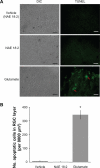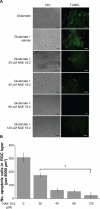Protection of neurons in the retinal ganglion cell layer against excitotoxicity by the N-acylethanolamine, N-linoleoylethanolamine
- PMID: 21573043
- PMCID: PMC3090310
- DOI: 10.2147/OPTH.S18309
Protection of neurons in the retinal ganglion cell layer against excitotoxicity by the N-acylethanolamine, N-linoleoylethanolamine
Abstract
Retinal ganglion cell (RGC) death is a hallmark of neurodegenerative diseases and disease processes of the eye, including glaucoma. The protection of RGCs has been an important strategy for combating glaucoma, but little clinical success has been reported to date. One pathophysiological consequence of glaucoma is excessive extracellular glutamate subsequently leading to excitotoxicity in the retina. Endocannabinoids, such as the N-acylethanolamine (NAE), arachidonylethanolamine (NAE 20:4), exhibit neuroprotective properties in some models of neurodegenerative disease. The majority of NAEs, however, are not cannabinoids, and their physiological function is not clear. Here, we determined whether the noncannabinoid NAE, linoleoylethanolamine (NAE18:2), protects neurons in the RGC layer against glutamate excitotoxicity in ex-vivo retina cultures. Using a terminal deoxynucleotidyl transferase-mediated dUTP (2'-deoxyuridine 5'-triphosphate) nick-end labeling (TUNEL) assay, we determined that NAE18:2 reduces the number of apoptotic RGC layer neurons in response to glutamate and conclude that NAE18:2 is a neuroprotective compound with potential for treating glaucomatous retinopathy.
Keywords: calcium signaling; eye; glaucoma; glutamate; immunocytochemistry; neuroprotection; vision.
Figures



Similar articles
-
Neuroprotective role of sphingolipid rheostat in excitotoxic retinal ganglion cell death.Exp Eye Res. 2021 Jul;208:108623. doi: 10.1016/j.exer.2021.108623. Epub 2021 May 19. Exp Eye Res. 2021. PMID: 34022173
-
Adenosine A3 receptor activation is neuroprotective against retinal neurodegeneration.Exp Eye Res. 2015 Nov;140:65-74. doi: 10.1016/j.exer.2015.08.009. Epub 2015 Aug 18. Exp Eye Res. 2015. PMID: 26297614
-
The protection of rat retinal ganglion cells from ischemia/reperfusion injury by the inhibitory peptide of mitochondrial μ-calpain.Biochem Biophys Res Commun. 2016 Sep 30;478(4):1700-5. doi: 10.1016/j.bbrc.2016.09.006. Epub 2016 Sep 3. Biochem Biophys Res Commun. 2016. PMID: 27596965
-
Neuroprotective Strategies in Glaucoma.Curr Pharm Des. 2016;22(14):2178-92. doi: 10.2174/1381612822666160128144747. Curr Pharm Des. 2016. PMID: 26818878 Review.
-
[Glutamate receptor-mediated retinal neuronal injury in experimental glaucoma].Sheng Li Xue Bao. 2016 Aug 25;68(4):483-91. Sheng Li Xue Bao. 2016. PMID: 27546508 Review. Chinese.
Cited by
-
Plasma Metabolomics of Intermediate and Neovascular Age-Related Macular Degeneration Patients.Cells. 2021 Nov 12;10(11):3141. doi: 10.3390/cells10113141. Cells. 2021. PMID: 34831363 Free PMC article.
-
Protective effects of 7,8-dihydroxyflavone on retinal ganglion and RGC-5 cells against excitotoxic and oxidative stress.J Mol Neurosci. 2013 Jan;49(1):96-104. doi: 10.1007/s12031-012-9899-x. Epub 2012 Oct 7. J Mol Neurosci. 2013. PMID: 23054592
-
Changes in Retinal N-Acylethanolamines and their Oxylipin Derivatives During the Development of Visual Impairment in a Mouse Model for Glaucoma.Lipids. 2016 Jul;51(7):857-66. doi: 10.1007/s11745-016-4161-x. Epub 2016 May 24. Lipids. 2016. PMID: 27221132 Free PMC article.
-
Synthesis of phenoxyacyl-ethanolamides and their effects on fatty acid amide hydrolase activity.J Biol Chem. 2014 Mar 28;289(13):9340-51. doi: 10.1074/jbc.M113.533315. Epub 2014 Feb 20. J Biol Chem. 2014. PMID: 24558037 Free PMC article.
-
N-Palmitoylethanolamine Prevents the Run-down of Amplitudes in Cortical Spreading Depression Possibly Implicating Proinflammatory Cytokine Release.Sci Rep. 2016 Mar 23;6:23481. doi: 10.1038/srep23481. Sci Rep. 2016. PMID: 27004851 Free PMC article.
References
-
- Weinreb RN, Khaw PT. Primary open-angle glaucoma. Lancet. 2004;363:1711–1720. - PubMed
-
- Yuan L, Neufeld AH. Tumor necrosis factor-alpha: a potentially neurodestructive cytokine produced by glia in the human glaucomatous optic nerve head. Glia. 2000;32:42–50. - PubMed
-
- Moreno MC, Campanelli J, Sande P, Sánez DA, Keller Sarmiento MI, Rosenstein RE. Retinal oxidative stress induced by high intraocular pressure. Free Radic Biol Med. 2004;37:803–812. - PubMed
-
- Seki M, Lipton SA. Targeting excitotoxic/free radical signaling pathways for therapeutic intervention in glaucoma. Prog Brain Res. 2008;173:495–510. - PubMed
-
- Hare WA, Wheeler L. Experimental glutamatergic excitotoxicity in rabbit retinal ganglion cells: block by memantine. Invest Ophthalmol Vis Sci. 2009;50:2940–2948. - PubMed
Grants and funding
LinkOut - more resources
Full Text Sources

